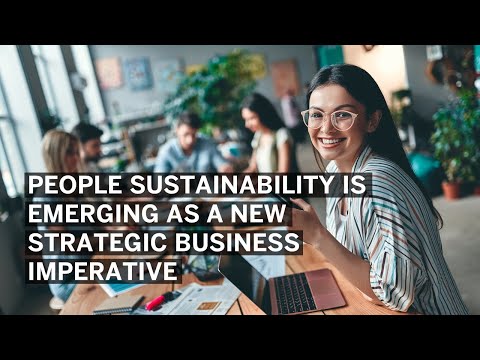There is no doubt that sustainability is transforming the global economy. Diminishing planetary resources, climate change, social and economic division, changing consumer preferences, employee activism, increasing regulations, and declining institutional trust are all leading to organizations being increasingly measured based on purpose as well as profit. And this is good for business.
Operating in a socially responsible way strengthens an organization’s brand reputation. Job seekers and consumers today want to support organizations that stand for something important and that are making positive impacts on society at large. Investors are putting more emphasis on sustainable development goals with a significant increase of focus on social impact. Human rights and environmental regulations are increasing rapidly. All of this demands a more sustainable approach from CEOs and business leaders.
People, Planet, and Prosperity
When you hear the word sustainability, the first thing you may think of is recycling or environmental sustainability, but sustainability is about so much more than eliminating single-use water bottles and reducing fossil fuel consumption. A holistic approach to sustainability incorporates social, environmental, and economic sustainability – or people, planet, and prosperity.
Organizations are increasingly recognizing the need to be as focused on social, or people, sustainability as they have been on economic and environmental sustainability – all three together support and drive business sustainability. People make up society, impact the environment, and power the economy. People are at the heart of any strategy to make progress on sustainability goals. In today’s workplace, HR has both the opportunity and responsibility to ensure that people are at the center of work by creating an environment in which the workforce, and the organization, can thrive.

Defining People Sustainability
People sustainability focuses on treating people – those within an organization’s workforce, across their supply chains, and in the communities in which they operate – ethically and fairly.
Just as environmental and economic sustainability require careful preservation and use of natural and financial resources, people sustainability requires treating people and human potential as precious resources that must be supported and valued to drive resilience, agility, and achievement of sustainability goals.
Companies that prioritize people sustainability, by creating social impact and building a more diverse and inclusive culture, are able to boost employee engagement and productivity. They’re also better positioned to attract and retain talent. Penny Stoker, global talent leader at EY, unpacks how people sustainability is at the core of building a better working world.
Unpacking the Six People Sustainability Pillars
The SAP SuccessFactors HR Research team has identified six distinct areas, or pillars, that comprise people sustainability. Although the areas are distinct, it is also clear that there is overlap between these pillars. At the center of them all, of course, is culture – as it drives so much behavior both within and outside an organization. Let’s unpack these areas a bit in the context of HR and people processes.
Health and Safety
At a minimum, you need to ensure the workforce is safe from physical health and safety hazards and has access to basic necessities. Does your onboarding process provide new hires with appropriate safety training and equipment from day one? Do you have visibility into your total workforce, including their locations? Knowing who and where your workforce is at all times allows you to react quickly in times of crisis and provide support where needed.
Diversity, Equity, and Inclusion
Here the focus is on treating each individual, regardless of social identity group or belief system, fairly and equitably and ensuring they feel a sense of true belonging. Are you able to attract and engage job seekers from diverse backgrounds? Do you have a standardized selection and interview process? Do you provide pay transparency? Are you measuring and tracking diversity, equity, and inclusion goals?
Well-Being and Balance
Beyond basic health and safety, this area focuses on ensuring employees’ holistic well-being – psychological, social, financial, and career – is prioritized and supported with the necessary tools and resources. Do you offer a comprehensive benefits package with compelling options? Do your employees feel comfortable bringing their whole selves to work? Have you fostered a culture of continuous dialogue between managers and their reports?
Trust and Transparency
The focus here is on employees having a voice, understanding how key decisions impacting them are made, and trusting their organization to act in ethical ways. Do you regularly listen to your employees and act on the feedback they provide? Have you established policies and processes for the ethical use of intelligent technologies and data privacy and protection? Do you publicly publish diversity metrics?
Empowerment and Growth
Here employees are provided the clarity, support, and tools needed to grow their skills and are empowered to influence their career trajectory. Are you offering inclusive learning options to meet the needs and learning preferences of a diverse workforce? Do you ensure managers provide equitable and actionable feedback to their teams? Are you providing equitable access to development opportunities?
Organizational Purpose and CSR
In this final pillar, the organization is actively working towards giving back and making a positive impact on the world; employees are encouraged to participate and feel energized by the organization’s mission and values. Do you ensure individual goals are aligned to company objectives to increase sense of purpose and meaning in work? Are you providing your workforce the space to pursue their passions?
What Can Organizations Do to Drive People Sustainability?
In most organizations today, different parts of the business lead these efforts with minimal awareness of or collaboration with each other’s strategies. However, we have to start somewhere. The most logical first step is to understand where you are today. Do you have a unified strategy – at least across some of these pillars? Start the conversations and begin to break down organizational silos.
Prioritize people, and planet and prosperity will follow. This is what it means to be a resilient, results-driven, and people-first organization. One that’s not only equipped to meet the business needs of today, but one that adapts to the business needs of tomorrow.
To learn more, watch a replay of the SuccessConnect keynote, Unleash the Power of Human Potential and Change Work for Good.
Kim Lessley is global director of Solution Marketing at SAP SuccessFactors.



